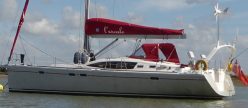Sunday 17 June
Early this morning, we slipped the lines and glided out of Riga’s City Marina, back down the Daugava River and out once again into the Baltic Sea. It struck me for the first time, that when leaving a port you look back and can name the landmarks and dominant buildings; the skyline already looks familiar, whilst only a few days ago you watched a new landscape sharpen into focus, enticing and waiting to be explored. Travelling by sea is always exciting, a privilege and humbling: I am aware of the thousands of sailors, merchants and explorers that have preceded us to each new landfall, at a slow and sedate pace, while the scene opens in front of our eyes. ‘Conventional’ forms of travel rarely afford this opportunity to really see the bigger picture of your destination as you arrive at the enclosed railway station or airport, or trying to navigate amidst busy traffic and baffling road signs.
In the early years of the 20th Century, English novelist Arthur Ransome was based in Latvia. Perhaps best known for his ‘Swallows and Amazons’ series of novels for young people, he worked as a foreign correspondent and journalist for the British press, reporting on Russian news, the First World War and the aftermath of the October Revolution. During this time, he commissioned the building of Racundra, and when she was finally launched, he sailed her from Riga to Tallinn, then known as Reval.
When we began our new cruising life in the summer of 2016, we explored the East Coast of England, bringing vividly to life the settings of some of Ransome’s children’s stories. By chance, I came across an edited republication of his record of his Estonian experiences in Racundra’s First Cruise. This week we are following his track.
It was a hot, calm day but we were able to motorsail with the mainsail and gennaker set during the afternoon. At 1600 we crossed the border into Estonia, and changed the courtesy flag again. As the wind filled in by early evening, we enjoyed a lovely sail for the last few miles, and arrived smoothly into Ringsu harbour on the island of Ruhnu.
Ransome’s passage from Riga to Runö, as it was then known in Swedish, took him around 24 hours, without the benefit of our wonderful, powerful engine. He described it as “the most romantic island in Northern Europe”, and it certainly had a lovely feel about it. The warm scent of sun-drenched pine trees wafted across the calm water, and we were flattered that the harbourmaster raised a Union Jack in our honour, among the collection of flags of visiting nations flying from his flagpoles.
In Ransome’s time, Runö was home to Swedish seal hunters, living “a life of medieval communism”, and numbering 270. The harbourmaster told us that nowadays the permanent community is around 50, which swells to 150 for the summer tourist season. The island is closer to Latvian mainland than Estonian, but nonetheless is counted among the 2222 islands of that nation, only 19 of which are inhabited.
Happy Fathers’ Day (at least in the UK)!
